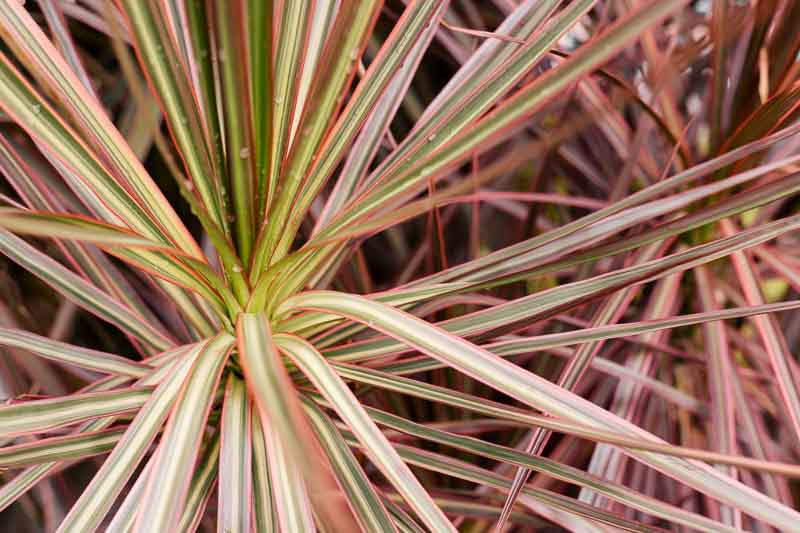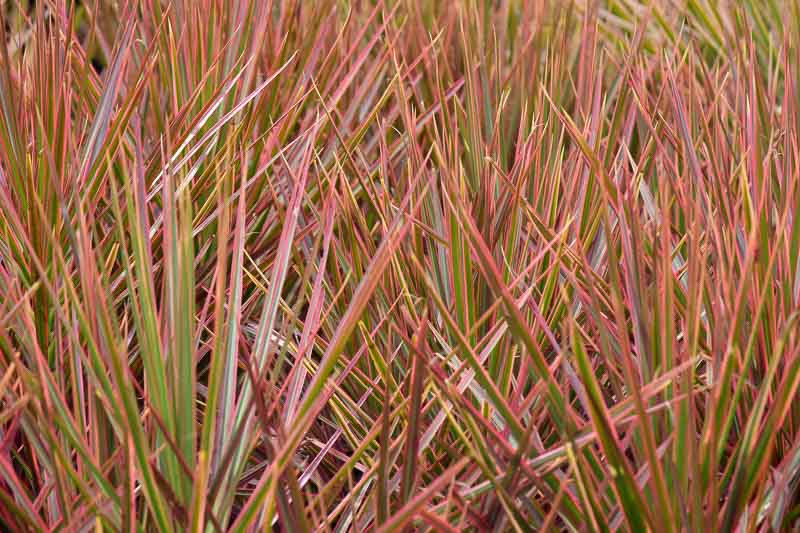Dragon Tree 'Tricolor', Madagascar Dragon Tree 'Tricolor', Dracaena cincta 'Tricolor', Dracaena 'Tricolour'
Dracaena marginata ‘Tricolor,’ also known as the Rainbow or Tricolor Dragon Tree, is a striking variety of the well-loved Dracaena family. Its colorful, narrow leaves and easy-care nature make it a popular choice among houseplant enthusiasts.
Dracaena marginata ‘Tricolor’ is distinguished by its long, slender leaves, which feature a harmonious blend of green, cream, and pink stripes, creating a stunning visual display. The plant grows with a slender, upright form, making it an ideal choice for adding vertical interest to indoor spaces.
Native: Dracaena marginata species is native to Madagascar, where it thrives in a range of conditions, from dry scrubland to moist, forested areas. It belongs to the asparagus family (Asparagaceae), along with agaves and hostas.
Plant Type and Habit: This variety is a sparsely branched evergreen shrub with a slow to moderate growth rate and an upright, branching habit. It tends to produce multiple stems from the soil line, each topped with a rosette of long, ribbon-like, variegated leaves.
Size: Indoors, ‘Tricolor’ can reach heights of up to 6 feet (1.8 meters) and spreads of around 3 feet (0.9 meters), depending on its age and growing conditions. Its moderate size makes it suitable for a variety of indoor settings. it can grow up to 15 feet (4.5 meters).
Longevity: Dracaena marginata boasts remarkable longevity, often thriving for decades with proper care. Indoors, its lifespan can extend beyond 20 years, making it a lasting companion in homes and offices.
Flowers: Like other Dracaena species, ‘Tricolor’ rarely blooms indoors. On the off chance that it does flower, the blooms are small, white, and fragrant, appearing in clusters. Fruiting is uncommon, especially indoors, but outdoor plants may produce small, orange-red berries following a successful bloom.
Foliage: The foliage is the standout feature of Dracaena marginata ‘Tricolor.’ The narrow and leathery leaves are lance-shaped, with a vibrant tricolor pattern that adds a splash of color to any room. The variegation includes a central cream stripe bordered by rich green, with crimson edges adding a unique contrast.
Bark: The stems are slender and flexible, with a grayish-brown bark. As the plant ages and lower leaves are shed, distinctive diamond-shaped leaf scars create an attractive pattern on the stems.
Hardiness: It is hardy in USDA zones 10 to 12, making it suitable for outdoor cultivation only in warm climates.
Award: Recipient of the prestigious Award of Garden Merit of the Royal Horticultural Society.
Uses: ‘Tricolor’ is primarily used as an indoor ornamental plant. Its air-purifying qualities and ability to thrive in low-light conditions make it a valuable addition to home and office environments.
Toxicity: Dracaena marginata is toxic to pets if ingested, causing symptoms like vomiting and drooling in cats and dogs.
Drought: This plant is notably drought-tolerant once established, requiring minimal watering and care.
Invasiveness: Dracaena marginata is not considered invasive outside its native range, mainly due to its cultivation as an indoor plant.
Benefits: Dracaena marginata is listed by NASA as an excellent plant for removing harmful chemicals from the air. Its ability to remove toxins from the air, such as benzene, formaldehyde, and trichloroethylene, makes it an excellent plant for improving indoor air quality.

Growing Dracaena marginata indoors is relatively straightforward, making it a popular choice for home and office environments. Here are the key tips for its care:
Light: Prefers bright, indirect light but can tolerate lower light conditions. Direct sunlight can scorch the leaves, so it’s best to avoid placing it in front of south-facing windows without any shade.
Soil: Use a well-draining potting mix. A mixture designed for succulents or cacti is ideal because it prevents water from pooling around the roots, which could lead to rot.
Water: Water sparingly, allowing the top inch of soil to dry out between watering sessions. Dracaena marginata is drought-tolerant and sensitive to overwatering, which is the most common cause of issues with this plant.
Temperature and Humidity: Prefers average room temperatures between 65°F to 80°F (18°C to 27°C). Avoid exposure to cold drafts or temperatures below 50°F (10°C), as it can harm the plant. Thrives in average household humidity. If your home is particularly dry, especially during winter months, you might consider using a humidifier or placing the plant on a pebble tray with water to increase humidity around it.
Fertilization: Feed lightly with a balanced, water-soluble fertilizer every 6 weeks during the growing season (spring and summer). Do not fertilize in the fall and winter when growth naturally slows down.
Pruning: To maintain its shape or encourage fuller growth, prune the plant by cutting back the main stem or removing unwanted branches. This can also stimulate new growth from the base.
Repotting: Dracaena marginata grows slowly, so repotting every 2-3 years is usually sufficient. Choose a pot that’s only slightly larger than the current one to avoid overwatering issues.
Growing Dracaena marginata outdoors can be a successful endeavor in the right climate. Typically suited to warmer, frost-free regions (USDA zones 10-12), here are guidelines to ensure its health and vibrancy when grown outside.
Light: Choose a spot that receives bright, indirect sunlight. While it can tolerate some direct sun, too much can scorch its leaves, especially in hotter climates.
Soil: Dracaena marginata prefers well-draining soil. Amend heavy clay soils with sand or compost to improve drainage. It’s adaptable to a range of soil pH levels.
Planting: The best time to plant is in spring or early summer when the weather is warm but not excessively hot. Dig a hole twice as wide and just as deep as the root ball. Place the plant in the hole and backfill with soil, ensuring it’s planted at the same depth it was in the pot. Water thoroughly after planting.
Water: Initially, water your Dracaena marginata regularly to help it establish. Once established, it’s quite drought-tolerant, but it will benefit from more consistent moisture than it would need indoors. Ensure good drainage to prevent water from pooling around the roots, which can lead to root rot.
Fertilization: Fertilize your outdoor Dracaena marginata with a balanced, slow-release fertilizer once at the beginning of the growing season to support healthy growth.
Mulching: Apply a layer of organic mulch around the base to help retain soil moisture and reduce temperature fluctuations.
Acclimatization: If your plant was previously indoors, gradually acclimate it to outdoor conditions to prevent shock.
Pruning: Prune as needed to control size and shape or to remove any damaged or yellowing leaves. Pruning can also encourage bushier growth.
Winter Care: In areas that experience cooler temperatures, provide protection during cold snaps or bring potted plants indoors if possible.

Propagating Dracaena marginata, commonly known as the Dragon Tree, is a straightforward process that can be done using stem cuttings. This method is effective for producing new plants that are true to the parent, and it’s a great way to rejuvenate an older plant that might be getting too tall or leggy. Here’s how to propagate Dracaena marginata:
Select a Healthy Stem: Choose a healthy, mature stem from the parent plant. Look for stems that are free of pests, diseases, and damage.
Cut the Stem: Using a clean, sharp knife or pruning shears, cut a section of stem about 4-6 inches long. Make sure the cutting includes at least one node (the point on the stem where leaves are attached), as this is where new roots will emerge.
Prepare the Cutting: Remove the leaves from the bottom half of the cutting to expose the nodes. If you’re taking a long cutting from the top of the plant, you can cut it into several sections, each with at least one node.
Let the Cutting Dry: Allow the cut end of the stem to dry and callous over for a day or two. This step helps prevent rot when the cutting is planted.
Rooting Medium: Fill a pot with a well-draining potting mix, such as a mix designed for cacti and succulents, or a mixture of peat and perlite. Moisten the soil slightly.
Plant the Cutting: Insert the cut end of the stem into the potting mix, ensuring the nodes are buried. You can use a rooting hormone to encourage root growth, but it’s not strictly necessary.
Create Humidity: To maintain humidity around the cutting, you can cover the pot with a plastic bag or place it in a propagator. Make sure to provide ventilation by opening the bag or propagator for a few hours each day to prevent mold growth.
Care for the Cutting: Place the pot in a warm, brightly lit area, but out of direct sunlight. Keep the soil lightly moist, but be careful not to overwater.
Root Development: Roots should begin to develop within a few weeks. You can check for root growth by gently tugging on the cutting. If there’s resistance, roots have likely formed.
Transplanting: Once the cutting has established a good root system, you can transplant it into a larger pot if necessary and begin regular care as for a mature Dracaena marginata.

Dragon Trees are known for their resilience and low susceptibility to pests and diseases. However, like all plants, they can encounter certain issues, especially when not grown in optimal conditions.
Spider Mites: These tiny pests thrive in dry conditions, sucking sap from leaves, leading to yellowing and webbing. Increase humidity and wash plants with water; use miticides if necessary.
Mealybugs: Look for white, cottony masses on stems and undersides of leaves. Remove with alcohol-dipped cotton swabs or apply insecticidal soap.
Scale insects: Hard, dome-shaped pests that attach firmly to stems and leaves, feeding on sap. Their presence can lead to yellowing leaves, stunted growth, and a decline in plant health.
Thrips: These tiny, slender insects feed on plants by puncturing and sucking their cell contents, causing silvering, discolored stippling, and distorted growth. They can spread viruses and are challenging to control due to their small size and rapid reproductive cycle.
Root rot: Overwatering is the primary cause of root rot, which is a fungal issue. Prevent by ensuring well-draining soil and pots, and only water when the soil is dry.
Leaf spot: Caused by fungal or bacterial infections, resulting in discolored spots on leaves. Improve air circulation, reduce leaf wetness, and treat with fungicides if necessary.
Brown Leaf Tips: Often a result of low humidity, fluoride or salt in tap water, or under-watering. Use distilled water or rainwater and mist the plant regularly.
Leaf Drop: Dracaena marginata may drop leaves in response to sudden changes in its environment, such as moving to a different location or a significant change in watering habits. Ensure consistent care and conditions to prevent shock.
Fading or Scorched Leaves: Direct sunlight can cause leaves to fade or develop scorched patches. Place the plant in a location where it will receive bright, indirect light.
The main difference between Dracaena marginata ‘Colorama’ and ‘Tricolor’ lies in their leaf coloring:
Yes, Dracaena marginata is predominantly grown as an indoor plant, especially in climates that do not mimic its native tropical and subtropical habitats. It is prized for its ease of care, air-purifying properties, and architectural form, making it a popular choice for homes and offices. While it can be grown outdoors in warm, frost-free climates (USDA zones 10-12), it thrives indoors across a wider range of locations.
The common name for Dracaena marginata ‘Tricolor’ is the Tricolor Dragon Tree or Rainbow Plant. The name reflects its striking variegated foliage that includes shades of green, white, and pink, giving it a distinctive, colorful appearance. Like its counterparts in the Dracaena genus, the ‘Tricolor’ is celebrated for its ornamental value and adaptability as an indoor plant.
| Hardiness |
10 - 12 |
|---|---|
| Heat Zones |
1 - 12 |
| Plant Type | Houseplants, Shrubs |
| Plant Family | Asparagaceae |
| Genus | Dracaena |
| Common names | Dragon Tree |
| Exposure | Partial Sun |
| Season of Interest |
Spring (Early, Mid, Late) Summer (Early, Mid, Late) Fall Winter |
| Height |
6' - 15' (180cm - 4.6m) |
| Spread |
3' - 10' (90cm - 3m) |
| Spacing |
36" - 60" (90cm - 150cm) |
| Maintenance | Low |
| Water Needs | Average |
| Soil Type | Chalk, Clay, Loam, Sand |
| Soil pH | Acid, Alkaline, Neutral |
| Soil Drainage | Moist but Well-Drained |
| Characteristics | Plant of Merit, Showy, Evergreen |
| Tolerance | Drought |
| Garden Uses | Beds And Borders, Patio And Containers |
| Garden Styles | Mediterranean Garden |
| Hardiness |
10 - 12 |
|---|---|
| Heat Zones |
1 - 12 |
| Plant Type | Houseplants, Shrubs |
| Plant Family | Asparagaceae |
| Genus | Dracaena |
| Common names | Dragon Tree |
| Exposure | Partial Sun |
| Season of Interest |
Spring (Early, Mid, Late) Summer (Early, Mid, Late) Fall Winter |
| Height |
6' - 15' (180cm - 4.6m) |
| Spread |
3' - 10' (90cm - 3m) |
| Spacing |
36" - 60" (90cm - 150cm) |
| Maintenance | Low |
| Water Needs | Average |
| Soil Type | Chalk, Clay, Loam, Sand |
| Soil pH | Acid, Alkaline, Neutral |
| Soil Drainage | Moist but Well-Drained |
| Characteristics | Plant of Merit, Showy, Evergreen |
| Tolerance | Drought |
| Garden Uses | Beds And Borders, Patio And Containers |
| Garden Styles | Mediterranean Garden |
How many Dracaena marginata ‘Tricolor’ (Dragon Tree) do I need for my garden?
| Plant | Quantity | |
|---|---|---|
| Dracaena marginata ‘Tricolor’ (Dragon Tree) | N/A | Buy Plants |
Create a membership account to save your garden designs and to view them on any device.
Becoming a contributing member of Gardenia is easy and can be done in just a few minutes. If you provide us with your name, email address and the payment of a modest $25 annual membership fee, you will become a full member, enabling you to design and save up to 25 of your garden design ideas.
Join now and start creating your dream garden!
Create a membership account to save your garden designs and to view them on any device.
Becoming a contributing member of Gardenia is easy and can be done in just a few minutes. If you provide us with your name, email address and the payment of a modest $25 annual membership fee, you will become a full member, enabling you to design and save up to 25 of your garden design ideas.
Join now and start creating your dream garden!